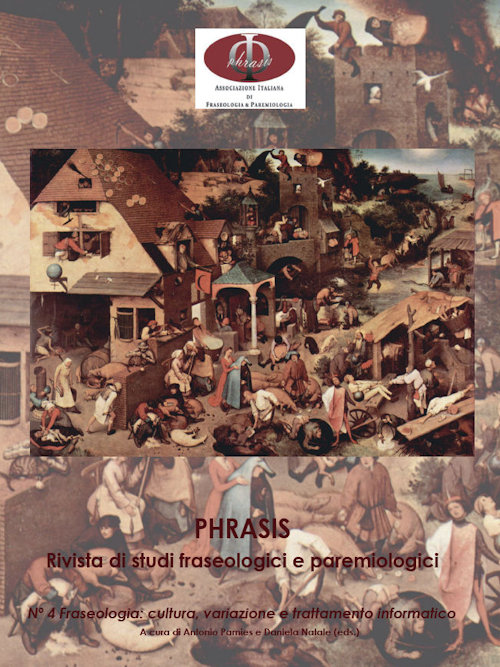El simbolismo de la orquídea en la fraseología china
Abstract
In this paper, on the basis of the Conventional Figurative Language Theory (Dobrovol’skij and Piirainen 2005), we focus on the symbolic background in the metaphorical use of the figure of orchid, and its traces in the figurative expressions, from a linguo-cultural perspective. First, we present a brief survey of the history of orchid in China and its role in Chinese art; then we analyze semantically and culturally a large number of idioms, figurative expressions, as well as some ancient poems. This study demonstrates the productivity of the orchid, reflecting its particular cultural connotations in the Chinese language. In this way, it provides reference materials which may facilitate learning, teaching and translation of Chinese, as well as intercultural communication. Besides, it also contributes to a better understanding of the interaction between language and culture especially between phraseology and culture.
Downloads
References
CHEN, Guohong [陈国弘] (dir.) (1988). Chengyu yu yuan dian gu ci dian成语语源典故词典 [“Diccionario de etimología y anécdotas sobre los Chengyu”]. Changsha: Yue lu shu she. 长沙: 岳麓书社.
CHEN, Junyu [陈俊愉] (1989). Zhong guo shi da ming hua 中国十大名花 [“Las diez flores más famosas en China”]. Shanghai: Shang hai wenyi chu ban she. 上海文艺出版社.
CHOY, Sin Hew (2001). Ancient Chinese orchid cultivation: A fresh look at an age-old practice. C.S. Hew / Scientia Horticulturae, 87, 1-10.
CORPAS PASTOR, Gloria (2003). “Acerca de la (in) traducibilidad de la fraseología”, in: Diez años de investigación en fraseología: análisis sintáctico- semánticos, contrastivos y traductológicos, Madrid: Iberoamericana: 275-310.
DOBROVOL’SKIJ, Dmitrij & PIIRAINEN, Elisabeth (2005). Figurative Language: Cross-cultural and Cross-linguistic Perspectives. Amsterdam: Elsevier.
DOBROVOL’SKIJ, Dmitrij. (2014). On the Semantic Structure of Idioms. Fraseología y paremiología: enfoques y aplicaciones, 23-32.
HAN DIAN汉典 [“Diccionario de chino”] (2004-2015) [en línea]. http://www.zdic.net/ [19.08.2020].
IÑESTA, Eva María & PAMIES, Antonio (2002). Fraseología y metáfora: aspectos tipológicos y cognitivos. Granada: Método.
JIA, Yongsheng (2013). Diccionario fraseológico- cultural de la lengua china. Granada: Granada Lingvistica.
KOEHN, Alfred (1952). Chinese Flower Symbolism. Monumenta Nipponica, 8 (1/2), 121-146.
LEI, Chunyi (2017). Estudio Contrastivo Linguo- Cultural del Lenguaje Figurado en Español y en Chino: Nombres y Fraseologismos Zoonímicos y Fitonímicos. Tesis doctoral. Granada: Universidad de Granada.
NAVARRO, Carmen & Dal MASO, Elena (2013). Análise culturolóxica da metáfora plantosémica en español e italiano. Cadernos de Fraseoloxía Galega, 15, 235-252.
PAMIES, Antonio (2007). “El lenguaje de la lechuza: apuntes para un diccionario intercultural”, in: Luque, J.d.D. & Pamies, A. (eds.): Interculturalidad y lenguaje: El significado como corolario cultural. Granada: Granada Lingvistica/ Método, 1, 375-404.
PAMIES, Antonio (2014). El algodón no engaña: algunas observaciones sobre la motivación en fraseología, in: Vanda Durante (ed.): Fraseología y paremiología: enfoques y aplicaciones, Centro Virtual Cervantes Instituto Cervantes: 33-50.
PAMIES, Antonio (2017) “The concept of cultureme from a lexicographical point of view”. Open Linguistics 3/1: 100-114.
PAMIES, Antonio & LEI, Chunyi (2014) “L’intraduisible? Dîtes-le avec des fleurs: Botanismes figuratifs et spécificité culturelle”, in: Dalmas, M.; Piirainen, E. & Filatkina, N. (eds.): Figurative Sprache / Figurative Language / Langage figuré: Festgabe für Dmitrij O. Dobrovol’skij. Tübingen: Stauffenburg: 19-40.
PIIRAINEN, Elisabeth (2011). “Idiom motivation from cultural perspectives: metaphors, symbols, intertextuality”, in: Pamies, A.; Dobrovol’skij, D. O. (eds.): Linguo-cultural competence and phraseological motivation, Baltmannsweiler: Schneider Verlag: 65-74.
WANG, Tao [王涛] et al. (dirs.) (1987). Zhong guo cheng yu da ci dian中国成语大辞典 [“Gran diccionario de Chengyu chino”]. Shanghai: Shang hai ci shu chu ban she. 上海:上海辞 书出版社.
XIAN DAI HAN YU CI DIAN (2002). 现代汉语 词典 [“Diccionario chino moderno”]. Beijing: Shang wu yin shu guan. 北京:商务印书馆. YU, Jinchun / SUN, Mengmei [ 余金淳 & 孙梦 梅] (dirs.) (2004). Han Yu Cheng Yu Ci Dian汉 语成语词典 [“Diccionario chino de frases hechas”]. Beijing: Shang wu yin shu guan guo ji you xian gong si. 北京: 商务印书馆国际有 限公司.
ZHENG, Xuanmu [郑宣沐] (dir.) (1988). Gu jin cheng yu ci dian古今成语词典 [“Diccionario de Chengyu antiguos y modernos”]. Beijing: Zhong hua shu ju. 北京: 中华书局.
ZYKOVA, Irina V. (2011). “Contrastive studies: levels and stages of research on phraseologisms of different languages”, in: Pamies, A. & Dobrovol’skij, D. O. (eds.): Linguo-cultural Competence and Phraseological Motivation, Baltmannsweiler: Schneider Verlag: 147-156.
Copyright (c) 2020 PHRASIS | Rivista di studi fraseologici e paremiologici

This work is licensed under a Creative Commons Attribution-ShareAlike 4.0 International License.
La rivista è pubblicata sotto licenza Creative Commons Attribution-ShareAlike 4.0 International License.










